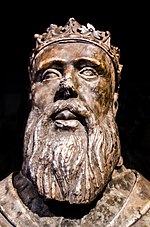Francis Hastings, 2nd Earl of Huntingdon



Francis Hastings, 2nd Earl of Huntingdon,
His maternal first cousins included Henry Stafford, 1st Baron Stafford and Henry Radclyffe, 2nd Earl of Sussex.
He was born in
As late as 1513, Anne was the courtier who received the second most expensive New Year's gift from Henry, indicating that their relationship continued until then. However, there are no contemporary references to the possibility of Francis being an illegitimate son of the
Marriage and children
Francis married Katherine Pole (1519 – 23 September 1576) on 25 June 1532. She was a daughter of
- Frances Anne Hastings (1533–1574). Married Henry Compton, 1st Baron Compton and was mother of William Compton, 1st Earl of Northampton.
- Henry Hastings, 3rd Earl of Huntingdon (1536 – 14 December 1595).
- William Hastings (born 1537).
- George Hastings, 4th Earl of Huntingdon (1540 – 3 December 1604).
- Sir Edward Hastings (1541–1603?). Married Barbara Devereux, daughter of Sir William Devereux and Jane Scudamore. Her paternal grandfather was Walter Devereux, 1st Viscount Hereford. She was the sole heir of both her father and her previous husband Edward Cayce. Her considerable inheritance included Leicester Abbey. Hans Francis Hastings, 12th Earl of Huntingdon and all subsequent Earls of Huntingdon are descended in the paternal line from Edward.
- Catherine Hastings (11 August 1542 – 22 September 1576). Married Henry Clinton, 2nd Earl of Lincoln and was mother of Thomas Clinton, 3rd Earl of Lincoln.
- Walter Hastings (1544 – 20 August 1616). Married Joyce Roper.
- Elizabeth Hastings (c. 1546 – 24 August 1621). Married Edward Somerset, 4th Earl of Worcester.
- Anne Hastings (born 1548).
- Francis Hastings (c. 1550 – 26 September 1610). Married Maud Longford.
- Mary Hastings (born 1552) (ru) – Ivan the Terrible's potential bride. The 1583 Russian Embassy to discuss the marriage was unsuccessful.
Political career
He seems to have gained some favour and was created a
He was a political supporter of
The
After this reasonable success for Huntingdon, Northumberland was able to provide his supporter with a membership in the
On 21 May 1553, his eldest son Henry married Katherine Dudley, the youngest daughter of their ally Northumberland. Huntingdon was among the nobles who signed the document proclaiming Lady Jane Grey heir of Edward VI. Jane was married to Lord Guildford Dudley, son to Northumberland and brother-in-law of Henry Hastings. Huntingdon probably held high hopes for his son under the new reign.
He was among the supporters of Jane in her brief reign (10 – 19 July 1553) but this reign ended in revolt in favour of her cousin
Hastings was a nephew by marriage of
He died in 1562 and was buried in St Helen's Church, Ashby-de-la-Zouch where his alabaster monument still exists in the Hastings Chapel. He was succeeded by his eldest surviving son Henry two years later.
References
- ISBN 978-0-7524-4835-0.
